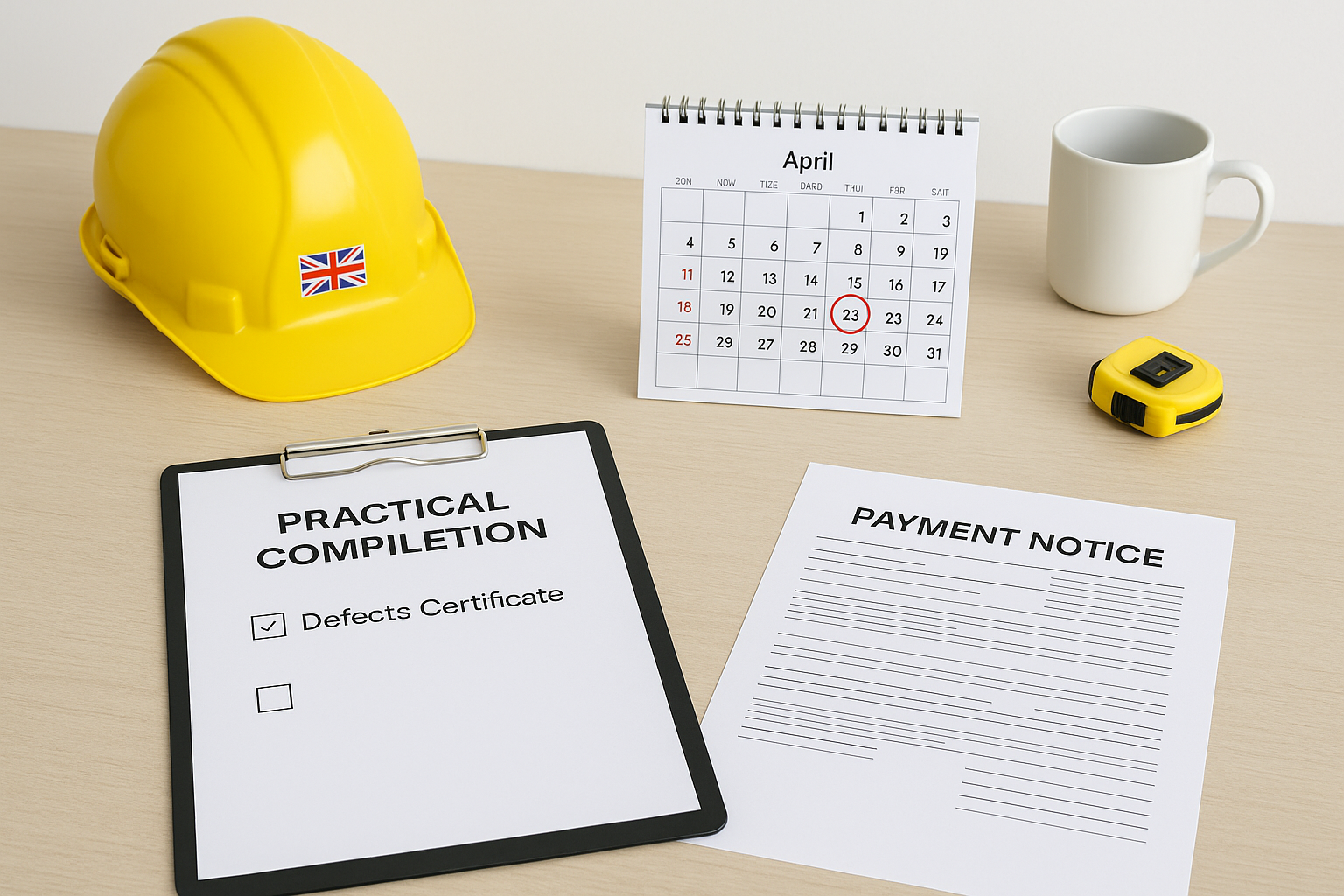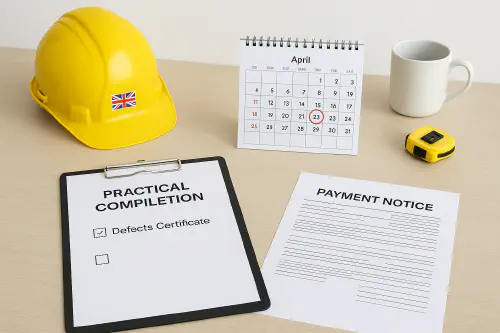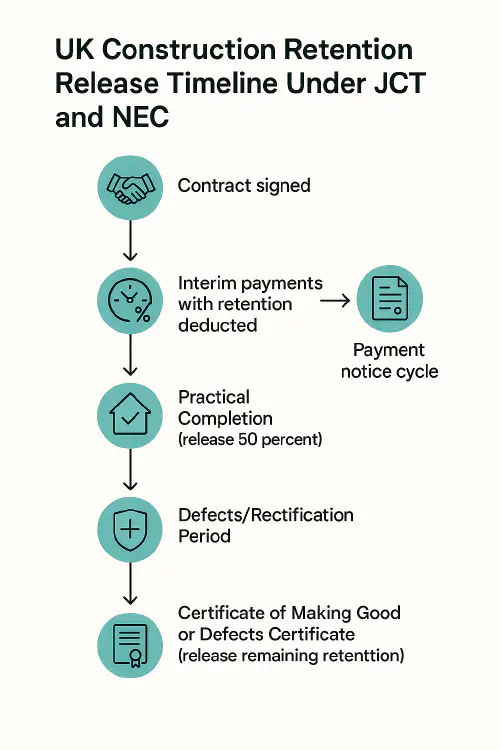
Release of retention in construction: JCT and NEC payment timeline, letters and automation tips
Release of retention in construction: JCT and NEC payment timeline, letters and automation tips
Category: Business & Operations • Niche: Contracts, getting paid, JCT and NEC

Site office desk with Practical Completion and Defects Certificate ticked and a payment notice on a clipboard
Contents
- Quick answer
- When is retention released under JCT and NEC
- Retention payment timetable you can copy
- Letter and email wording to trigger release
- Evidence pack to avoid disputes
- Automation tips to never miss a release date
- Common gotchas and fixes
- Further reading and references
- FAQs
Quick answer
- JCT contracts: retention is normally split into two equal halves. First half is released at Practical Completion. The balance is released when the contract administrator issues the Certificate of Making Good after the defects period. Your contract sets the exact percentages and dates.
- NEC contracts: retention only applies if Option X16 is included. Half is released at Completion or Takeover; the remainder is released when the Supervisor issues the Defects Certificate. NEC lets you set a retention-free amount and use retention bonds instead of cash.
- Payment law still applies. The payer must issue a payment notice within 5 days of the due date and must pay the “notified sum” by the final date for payment unless a valid pay less notice is served on time. See the Construction Act sections on payment notices and pay less notices on legislation.gov.uk and section 111.

Flowchart showing retention deductions, Practical Completion, Defects period and final release under JCT and NEC
When is retention released under JCT and NEC
JCT in practice
- Trigger 1: Practical Completion certificate issued by the contract administrator. Commonly releases 50 percent of the retention.
- Trigger 2: Certificate of Making Good following the end of the Rectification Period when listed defects are remedied. Releases the remaining retention.
- Useful background: JCT explains interim payments and calendars using Interim Valuation Dates in its guidance. See JCT explains: Interim Payments. A general overview of retention is on Designing Buildings Wiki.
NEC in practice
- Only if X16 is used. If it is:
- First release at Completion or Takeover.
- Final release at the due date of the Defects Certificate, provided defects are dealt with.
- NEC highlights alternatives to cash retentions such as performance bonds, parent guarantees or retention bonds. See NEC news and guidance on limiting retentions: NEC Contracts guidance.
Retention payment timetable you can copy
Below is a model cycle you can adapt. Always check your specific contract.
- Day 0: Your Interim Valuation Date or application date.
- Due date: As stated in your contract (often same day or a set number of days after Day 0).
- Payment notice: Must be issued within 5 days after the due date. If the payer fails, you can issue a default notice. See Construction Act s110A.
- Pay less notice: Not later than 7 days before the final date for payment. See the 2011 Scheme amendment Regulation 4.
- Final date for payment: As your contract states. If silent, the statutory Scheme sets 17 days after the due date. See the Scheme on legislation.gov.uk.
- Retention releases: Add PC and Making Good or Defects Certificate to your tracker. Apply for the retention on the next payment cycle after the trigger.
Pro tip: Missing a pay less notice usually means the notified sum must be paid even if the payer disputes it. That is why a tight notice calendar matters. See section 111.
Letter and email wording to trigger release
Copy, paste and adapt. Send as soon as the trigger certificate is issued and include your supporting evidence (below).
Subject: Retention release request – [Project name], [Contract ref]
Dear [Name],
Further to the [Practical Completion/Defects Made Good] certificate dated [dd/mm/yyyy], please include the release of retention in the next payment cycle in accordance with our contract.
Key details
- Contract: [Form and date]
- Retention: [x%] of the Contract Sum, split [e.g., 50/50]
- Trigger: [PC certificate / Certificate of Making Good / NEC Defects Certificate] attached
- Amount due now: £[amount]
Please issue the payment notice by [date] and arrange payment by the final date for payment of this cycle. If anything is missing, let me know today.
Regards,
[Name]
[Company]
For late releases, escalate with a firm but professional reminder that references the Construction Act “notified sum” and pay less deadlines. For wording and a full chase flow, see our guide on late payment fees for trades.
Evidence pack to avoid disputes
Attach or link:
- PC certificate and, later, the Certificate of Making Good or NEC Defects Certificate.
- Defects schedule and your photo evidence that items are resolved.
- Latest valuation or payment application showing retention calculation.
- Handover documents as relevant: manuals, test certificates, warranties. See our handover guidance on assembling client packs efficiently in related content.
Good resources on defects and certificates: Pinsent Masons Out-Law guide and NEC’s short notes on retentions.
Automation tips to never miss a release date
- Calendar the trigger dates on day one. Enter the planned Practical Completion date and the end of the defects period in your job management calendar. Add reminders for: payment notice issue date, pay less deadline, final date for payment.
- Use a retention tracker column in your spreadsheet or job system. Status options: “Held,” “Half released at PC,” “Final released.”
- Auto-generate emails when a certificate is uploaded. Many systems can watch a folder and draft the retention request using a template.
- Replace cash retention with a retention bond where accepted. It preserves cash flow and is supported by NEC X16.3. NEC and the CLC have published guidance encouraging alternatives to cash.
- If the client is slow historically, adopt a strict chase flow with interest on late commercial payments. Our wording and flow here will help: late payment fees for trades.
Common gotchas and fixes
- No explicit retention clause. If your contract is silent, you still have to follow the Construction Act payment machinery, but retention triggers will not be defined. Agree them in writing before you start.
- “PC” is argued. Keep a contemporaneous snag list and photos. Ask the contract administrator for the certificate in writing when milestones are met.
- Pay less notice arrives late. It is invalid if outside the window. Respond by pointing to the dates and request payment of the notified sum.
- Insolvency risk upstream. Cash retentions can be vulnerable. Consider retention bonds, performance bonds or guarantees instead and keep values as low as the market allows. See NEC and CLC guidance.
- Variations push dates. Update your tracker whenever the programme or defects period changes and re-issue your timetable to accounts.
Further reading and references
- Construction Act payment notices and pay less notices: s110A and s111.
- The Scheme default timings: 1998 Scheme and 2011 Amendments.
- JCT 2024 suite release notes: JCT announcement.
- NEC notes on retentions and alternatives: NEC guidance.
- Background explainer on retention: Designing Buildings Wiki and NBS overview.
- Transparency trend: large firms will need to report on retention practices under updated reporting regs from 2025. See Gowling WLG summary.
- Related Academy guides: variations process that gets paid first time: Variation order in construction.